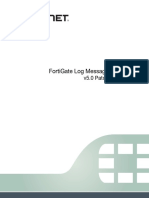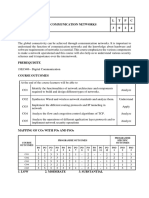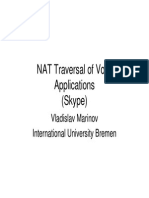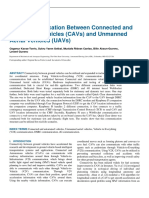EC8551 CN Syllabus
Uploaded by
RagavanEC8551 CN Syllabus
Uploaded by
RagavanEC8551 COMMUNICATION NETWORKS L T PC
3 0 0 3
OBJECTIVES:
The student should be made to:
Understand the division of network functionalities into layers.
Be familiar with the components required to build different types of networks
Be exposed to the required functionality at each layer
Learn the flow control and congestion control algorithms
UNIT I FUNDAMENTALS & LINK LAYER 9
Overview of Data Communications- Networks – Building Network and its types– Overview
of Internet - Protocol Layering - OSI Mode – Physical Layer – Overview of Data and Signals
- introduction to Data Link Layer - Link layer Addressing- Error Detection and Correction
UNIT II MEDIA ACCESS & INTERNETWORKING 9
Overview of Data link Control and Media access control - Ethernet (802.3) - Wireless LANs
– Available Protocols – Bluetooth – Bluetooth Low Energy – WiFi – 6LowPAN–Zigbee -
Network layer services – Packet Switching – IPV4 Address – Network layer protocols ( IP,
ICMP, Mobile IP)
UNIT III ROUTING 9
Routing - Unicast Routing – Algorithms – Protocols – Multicast Routing and its basics –
Overview of Intradomain and interdomain protocols – Overview of IPv6 Addressing –
Transition from IPv4 to IPv6
UNIT IV TRANSPORT LAYER 9
Introduction to Transport layer –Protocols- User Datagram Protocols (UDP) and
Transmission Control Protocols (TCP) –Services – Features – TCP Connection – State
Transition Diagram – Flow, Error and Congestion Control - Congestion avoidance (DECbit,
RED) – QoS – Application requirements
UNIT V APPLICATION LAYER 9
Application Layer Paradigms – Client Server Programming – World Wide Web and HTTP -
DNS- - Electronic Mail (SMTP, POP3, IMAP, MIME) – Introduction to Peer to Peer
Networks – Need for Cryptography and Network Security – Firewalls.
TOTAL: 45 PERIODS
OUTCOMES:
At the end of the course, the student should be able to:
Identify the components required to build different types of networks
Choose the required functionality at each layer for given application
Identify solution for each functionality at each layer
Trace the flow of information from one node to another node in the network
TEXT BOOK:
1. Behrouz A. Forouzan, “Data communication and Networking”, Fifth Edition, Tata
McGraw – Hill, 2013 (UNIT I –V)
REFERENCES:
1. James F. Kurose, Keith W. Ross, “Computer Networking - A Top-Down Approach
Featuring the Internet”, Seventh Edition, Pearson Education, 2016.
2. Nader. F. Mir, “Computer and Communication Networks”, Pearson Prentice Hall
Publishers, 2nd Edition, 2014.
3. Ying-Dar Lin, Ren-Hung Hwang, Fred Baker, “Computer Networks: An Open Source
Approach”, Mc Graw Hill Publisher, 2011.
4. Larry L. Peterson, Bruce S. Davie, ―Computer Networks: A Systems Approach‖,
Fifth Edition, Morgan Kaufmann Publishers, 2011.
You might also like
- Al-Razi Academic Notes Computer Science & Entrepreneurship100% (1)Al-Razi Academic Notes Computer Science & Entrepreneurship26 pages
- CS8591 Computer Networks L T P C 3 0 0 3 Objectives0% (1)CS8591 Computer Networks L T P C 3 0 0 3 Objectives5 pages
- Mookambigai College of Engineering: Srinivasa Nagar, Kalamavur, Pudukkottai - 622502No ratings yetMookambigai College of Engineering: Srinivasa Nagar, Kalamavur, Pudukkottai - 62250235 pages
- Fundamentals of Networking Course OutlineNo ratings yetFundamentals of Networking Course Outline4 pages
- Cse3006 Computer-Networks LTP 1.0 1 Cse3006 R1No ratings yetCse3006 Computer-Networks LTP 1.0 1 Cse3006 R13 pages
- 03_23CSE401_Data Communication and NetworksNo ratings yet03_23CSE401_Data Communication and Networks4 pages
- Course Code Course Title LTPC 1151EC111 Data Communication Networks 2 2 0 3 Course Category: A. PreambleNo ratings yetCourse Code Course Title LTPC 1151EC111 Data Communication Networks 2 2 0 3 Course Category: A. Preamble2 pages
- Syllabus: Ec2352 Computer Networks L T P C ' 3 0 0 3 Unit I Physical Layer 9No ratings yetSyllabus: Ec2352 Computer Networks L T P C ' 3 0 0 3 Unit I Physical Layer 94 pages
- CSE3006 - Computer Networks - V2 - SyllabusNo ratings yetCSE3006 - Computer Networks - V2 - Syllabus3 pages
- Mookambigai College of Engineering: Srinivasa Nagar, Kalamavur, Pudukkottai - 622502No ratings yetMookambigai College of Engineering: Srinivasa Nagar, Kalamavur, Pudukkottai - 62250255 pages
- Computer Networks: III B.Tech-II Semester LTPC Course Code: A10519 3 1 - 3 Course OverviewNo ratings yetComputer Networks: III B.Tech-II Semester LTPC Course Code: A10519 3 1 - 3 Course Overview2 pages
- CSE2037 Basics of Data Communication and Computer Networks.docxNo ratings yetCSE2037 Basics of Data Communication and Computer Networks.docx10 pages
- Sardar Raja College of Engineering, Raja Nagar, Alangulam: Department of Computer Applications Micro Lesson PlanNo ratings yetSardar Raja College of Engineering, Raja Nagar, Alangulam: Department of Computer Applications Micro Lesson Plan9 pages
- Bece401l Computer-Communications-And-Networks TH 1.0 0 Bece401lNo ratings yetBece401l Computer-Communications-And-Networks TH 1.0 0 Bece401l3 pages
- Introduction to Internet & Web Technology: Internet & Web TechnologyFrom EverandIntroduction to Internet & Web Technology: Internet & Web TechnologyNo ratings yet
- Red Hat Enterprise Linux-5-Tuning and Optimizing Red Hat Enterprise Linux For Oracle 9i and 10g Databases-En-USNo ratings yetRed Hat Enterprise Linux-5-Tuning and Optimizing Red Hat Enterprise Linux For Oracle 9i and 10g Databases-En-US136 pages
- NI LabVIEW For CompactRIO Developer's Guide-59-84No ratings yetNI LabVIEW For CompactRIO Developer's Guide-59-8426 pages
- Server Port Forwarding Guidelines Rev O EN 12-2022No ratings yetServer Port Forwarding Guidelines Rev O EN 12-202213 pages
- Esp32 at Instruction Set and Examples enNo ratings yetEsp32 at Instruction Set and Examples en58 pages
- 23Process-to-Process Delivery - UDP, TCP, and SCTPNo ratings yet23Process-to-Process Delivery - UDP, TCP, and SCTP13 pages
- InDTU332 and 324 User Manual V1.0-20191125No ratings yetInDTU332 and 324 User Manual V1.0-2019112557 pages
- Nat Traversal of Voip Applications (Skype) : Vladislav Marinov International University BremenNo ratings yetNat Traversal of Voip Applications (Skype) : Vladislav Marinov International University Bremen27 pages
- V2X Communication Between CAVs and UAVsNo ratings yetV2X Communication Between CAVs and UAVs11 pages
- Transport Layer: User Datagram Protocol (UDP)No ratings yetTransport Layer: User Datagram Protocol (UDP)3 pages

























































































